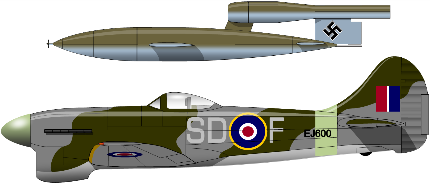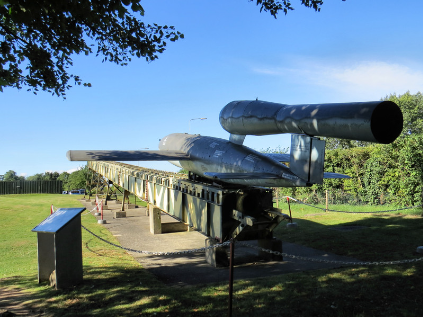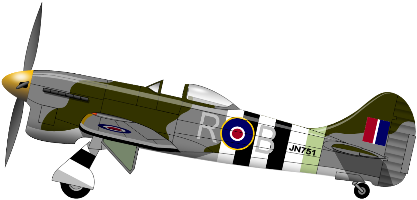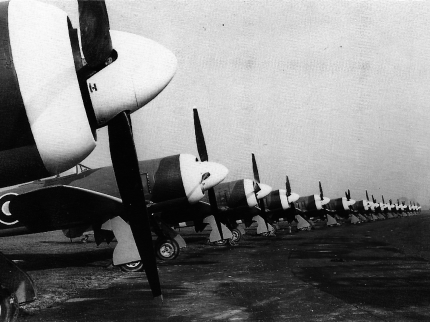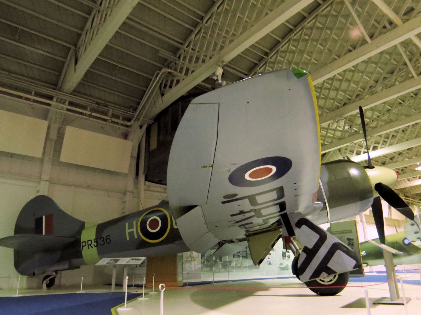
Hawker Tempest
Development
During the development of the Typhoon, Sydney Camm’s design team at Langley were already planning its replacement initially known as Typhoon II. The new aircraft incorporated low drag laminar flow wing developed by NACA in the United States. This resulted in thinner elliptical wings resembling those of the Spitfire. The thinner wings meant that room had to be found in the fuselage for fuel tanks.
The Air Ministry asked for six prototypes with different engines to cover the possibility of delay in the supply of any particular type. A summary of five different prototype marks with the engine types and body configurations is given here.
Mark I prototype HM599 had a Napier Sabre IV engine with no nose radiator and a Typhoon-style tail. The cockpit was of ‘car door’ type. First flew 24 February 1943. With its clean nose, the top speed of this mark was 466mph (750kmph) making it the fastest Hawker aircraft to that time. The Sabre IV engine was unreliable however, and only one aircraft was built.
Mark I prototype HM599
Mark II prototype LA602 had a Bristol Centaurus IV radial engine and a Typhoon-style tail. The cockpit was a sliding type. Hawker revisited this design and produced it for service in the Far East after the Second World War when Bristol Centaurus IV engines were more readily. The war in Europe and against Japan ended before the Tempest II went into service.
Mark III prototype LA610 had a Rolls-Royce Griffon IIB engine and a Typhoon-style tail. The cockpit was a sliding type.
Mark IV was a cancelled project.
Mark V prototype HM595 had a Napier Sabre II engine with a scoop radiator and a Typhoon-style tail. The cockpit was of ‘car door’ type. It first flew on 2 September 1942. This was the chosen type to be further developed with a revised tail and sliding cockpit. The aircraft soon became known as the Tempest and the mark V went into production with the first off the line on 21 June 1943.
Mark V prototype HM595 was flown by Philip Lucas on its maiden flight on 2 September 1942 from Langley
Mark VI was developed from Mk V converting its prototype, HM595, which made its first flight as a Mk VI on 9 may 1944. Two other Mk Vs, EJ841 and JN750, were also converted for evaluation. 142 were built.
Tempest V
The Tempest V entered service in March/April 1944 with 3 Squadron, 486 (NZ) Squadron and later 56 Squadron. These units formed 150 wing led by Wing Commander Roland Beamont based at RAF Newchurch in Kent. Operations included high-altitude fighter sweeps and ‘Rangers’ which were ground attack sorties in enemy territory.
In June 1944, Germany began launching V-1 attacks on London. The Fieseler Fi103 V-1 Flying Bomb or ‘Doodlebug’ carried a warhead of 1,870 lb of Amatol-39 and had a range of 160 miles. They were fired from launch ramps in the Netherlands and flew at 400mph at 2,000-3,000ft.
Because of its low-altitude speed, the Tempest was the preferred allied fighter to use to intercept the missiles and 150 Wing were assigned the task. Other aircraft types were later developed but the Tempest destroyed the greatest number; 638 out of a total of 1,846 claimed by RAF pilots.
V-1 flying bomb with Tempest V EJ600/SD-F of 501 Squadron flown by Squadron Leader Joseph Berry who shot down 59 V-1s.
Dealing with V-1s was a difficult and dangerous task because if the aircraft’s cannon caused the warhead of the V-1 to blow up, the chasing aircraft could be caught up in the explosion and itself destroyed. A safer way to dispose of them was for the pilot to manoeuvre his aircraft so that one of his wing tips came within 6 inches of the underside of a wing of the missile. The airflow from the fighter would disrupt the airflow under the missile and it would flip over to crash short of its target into the sea or less populated countryside.
Another solution was pioneered by Wing Commander Roland Beamont. He had the cannon on his aircraft realigned so that the shells would converge at three hundred yards. This meant the missiles could be shot down at a greater and safer distance.
A replica V-1 ‘Doodlebug’ and launch ramp at Duxford
By September 1944 the V-1 threat had receded and Tempests based in South-western England flew armed reconnaissance sorties in support of Operation Market Garden, the airborne attempt to seize a bridgehead across the Rhine.
Tempest in air to air combat
Tempests from 135 Wing were used against the new German jet fighter the Messerschmitt Me262 using a tactic known as ‘Rat Scramble’. When a Me262 was reported to be in the air Tempests on alert would take off but instead of trying to engage the fast jet, they would fly to their base at Rheine-Hopsten to attack them as they tried to land when they were at their most vulnerable.
Tempest Mk V JN751/R-B of 150 Wing RAF 1944 flown by Wing Commander Roland Beamont DSO DFC who destroyed 32 V-1 flying bombs and 9 conventional manned aircraft.
Tempest units achieved an estimated success ratio of 6:1 ratio against single-seat enemy fighters. Top gun was Squadron Leader David C ‘Foobs’ Fairbanks. He was an American who joined the RCAF in 1941 and scored 11 or 12 kills by 1945 when he was shot down and made a POW.
Performance Tempest V
Powerplant 1 x Napier Sabre IIA 2,180 hp
Maximum speed 432 at 18,400 ft
Range 740 miles
Ceiling 36,500 ft
Rate of climb 4,700 ft/min
Power/mass 0·21 hp/lb
Armament consisted of four 20mm cannon and either eight air to ground rockets or two 500 lb or 1,000 lb bombs. A total of 1,702 Tempests were built.
Tempest II
The Tempest II was destined for operations against the Japanese in the Far East but the war ended before it was deployed. Three squadrons were sent to post-war Germany and four squadrons were sent to India. In 1949 Tempest IIs of 33 Squadron were sent from Germany to be used in the ground attack role against terrorists in Malaya. It was powered by a Bristol Centaurus radial engine and was considered to be one of the most powerful fighters of its day.
At least twenty Tempest II fresh off the production line
At the end of the Second World War and into the Post War era, a wider choice of engines became available. This meant that the Tempest II powered by the Bristol Centaurus 18 cylinder radial engine could be revived. Two prototypes were completed, the design owing much to the examination of a captured Focke-Wulf Fw 190 earlier in the war.
Tempest II prototype LA602 flew on 28 June 1943. It initially had a Typhoon style fin and rudder unit and had a four-bladed propeller. The second prototype LA607 had a larger and rudder and first flew on 18 September 1943. This prototype was used primarily for engine development.
Tempest II MW800 of No 54 Squadron, 1946, flown by Squadron Leader FWM Jensen
The Tempest II had been intended for operations against the Japanese in the Far East but it suffered production delays for a number of reasons and the war ended before it could be deployed.
Production began in October 1944 with 50 being built by Bristol Aircraft. With the end of the war coming production was switched to Hawkers who built 402, 100 as fighters, 302 as FB II fighter-bombers with strengthened wings and wing racks for bombs up to 1,000 lbs.
Three squadrons were sent to post-war Germany and four squadrons were sent to India. In 1949 Tempest IIs of 33 Squadron were sent from Germany to be used in the ground attack role against guerrillas of the Malayan Races Liberation Army during the early stages of the Malayan Emergency.
Performance Tempest II
Powerplant 1 x Bristol Centaurus V or VI, 2,526 hp
Maximum speed 440 at 15,000 ft
Range 800 miles or 1,640 miles with drop tanks
Ceiling 37,000 ft
Armament consisted of four 20mm cannon and either eight air to ground rockets or two 500 lb or 1,000 lb bombs. A total of 472 Tempests were built, 422 by Hawker and 50 by Bristol.
PR536/OQ-H Mk II is on display at the RAF Museum, Hendon
My name is Gary Flint. I'm author, photographer & illustrator for Postcards from Slough. If you wish to make any comments on the contents of the website please click on the ladybird below:
Gary Flint
08/03/1961 - 09/04/2019
Postcards from Slough is an independently funded website. We are open to offers of sponsorship from companies that have any connections to the town. To contact us please click on the ladybird below:
Chalvey Community Forum
Postcards from Slough is linked with a local action group the Chalvey Community Forum. The group liaises with various local organisations in order to improve the quality of life for residents in the ward of Chalvey and Salt Hill. To learn more please click on the maidenhair leaf below:
Museum of Berkshire Aviation
I volunteer as a guide at the Museum of Berkshire Aviation. It is a special museum and if you would like to know more about the museum then please click on the motif below:
To learn more about the museums activities while staying within this website click on the tab at the top of the page or on the motif below:
Graces Guide
Postcards from Slough uses some images from Grace's Guide. Click on the button below:
British Listed Buildings
Postcards from Slough contributes material to British Listed Buildings and uses the site for cross referencing purposes. Click on the button below:


